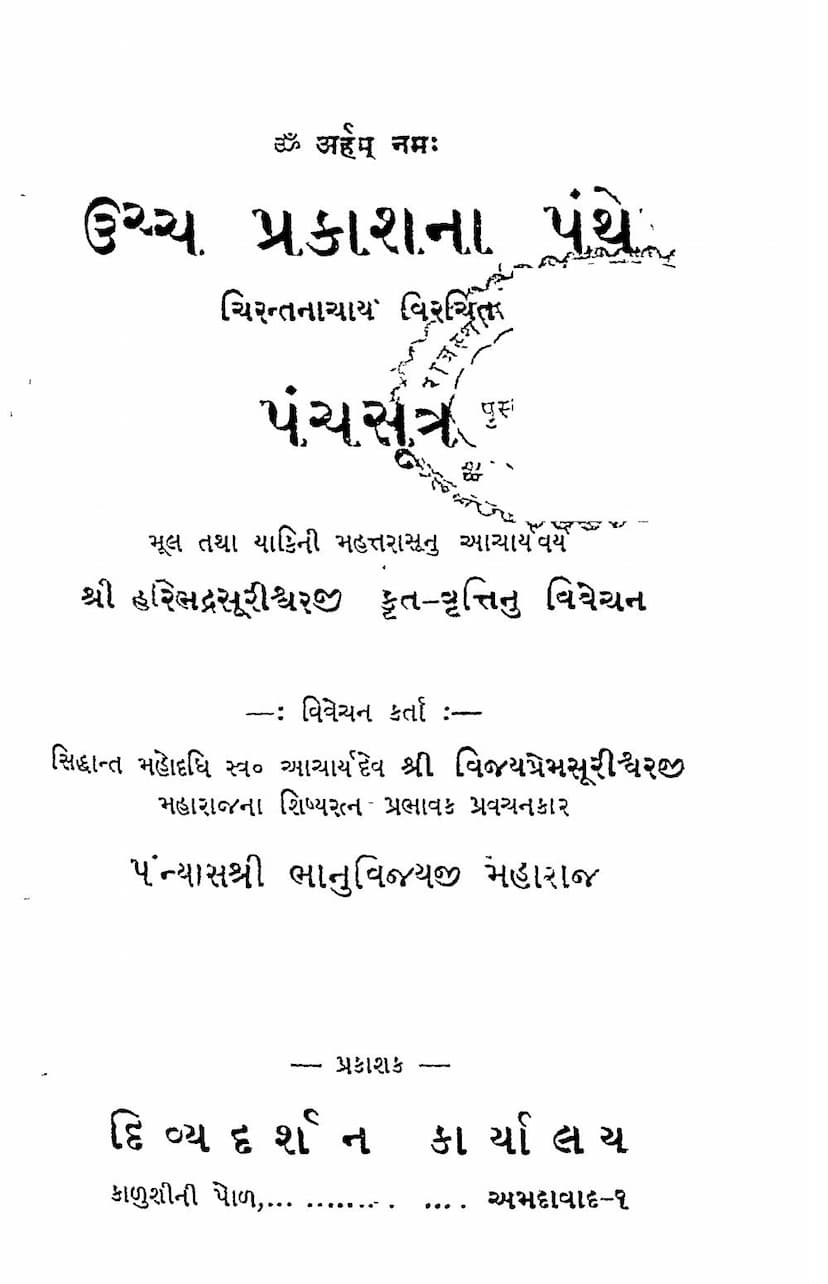Panchsutra
Added to library: September 2, 2025

Summary
The Jain text "Panchesutra" by Bhanuvijay, published by Divya Darshan Trust, is a commentary and explanation of the original "Panchesutra" text and the commentary by Acharya Haribhadrasuri. The work is presented by Pandit Bhanuvijayji Maharaj, a disciple of Acharya Vijay Premsurishwarji Maharaj.
The book is divided into five chapters, each focusing on a specific aspect of Jain philosophy and practice, outlined by the five "sutras" or aphorisms:
-
Pap-Pratighat-Gun-Beej-Aadhan (Elimination of Sin and Sowing Seeds of Virtue): This initial sutra emphasizes the importance of eradicating negative karmas and cultivating virtuous qualities. It highlights the need to understand the true nature of the soul, free from the ego and the concept of "mine," which are seen as the root causes of spiritual degradation and the cycle of birth and death. It stresses the importance of true devotion to the Tirthankaras and Gurus.
-
Sadhu-Dharma-Paribhavna (Cultivation of the Path of a Monk): This chapter delves into the principles and practices essential for spiritual aspirants who wish to follow the path of a monk. It emphasizes developing virtues like non-violence, truthfulness, contentment, and compassion. The text highlights the need for self-reflection and the cultivation of pure thoughts, speech, and actions, while also stressing the importance of renouncing worldly attachments and desires.
-
Pravajya-Grahan-Vidhi (Procedure for Ascetic Initiation): This section meticulously outlines the process of renouncing worldly life and embracing asceticism. It covers the preparatory steps, the importance of parental consent (if applicable), and the rituals involved in initiation. The text emphasizes the need for sincere devotion and spiritual readiness before taking such a significant step, underscoring that the initiation ceremony itself is a sacred act that requires meticulous observance.
-
Pravajya-Paripalan (Upholding Asceticism): This chapter focuses on the diligent and unwavering adherence to the vows and principles of asceticism. It stresses the necessity of maintaining purity in thought, speech, and action, and the continuous effort to overcome internal obstacles like passions and the cycle of karma. The importance of seeking guidance from a Guru and adhering to the scriptures is also highlighted.
-
Pravajya-Phal (The Fruit of Asceticism): The final sutra discusses the ultimate goal of asceticism – liberation (Moksha). It describes the state of the Siddhas as eternal, omniscient, omnipotent, and blissful, free from all worldly suffering and karmic bondage. The text emphasizes that the path of righteousness, guided by right faith, knowledge, and conduct, leads to this ultimate liberation.
Key Themes and Concepts:
- The Nature of the Soul: The text expounds on the soul's true nature as eternal, pure, and inherently blissful, which is obscured by karmic influences.
- Karma and Liberation: A central theme is the concept of karma and its role in the cycle of birth and death. The text explains how eliminating negative karmas and cultivating positive ones, through practices like austerities and ethical conduct, leads to liberation.
- Importance of Guru and Scriptures: The guidance of a true Guru and adherence to the sacred scriptures (Agamas) are repeatedly emphasized as essential for spiritual progress.
- The Path of Asceticism: The book provides a comprehensive guide to the rigorous yet rewarding path of an ascetic, detailing the practices and mindset required for spiritual advancement.
- Virtues and Ethical Conduct: The text underscores the practice of virtues like non-violence (ahimsa), truthfulness (satya), non-stealing (asteya), celibacy (brahmacharya), and non-possession (aparigraha) as foundational for spiritual growth.
- Overcoming Obstacles: It addresses common obstacles on the spiritual path, such as attachment, ego, passions, and worldly distractions, and offers guidance on how to overcome them.
- The Goal of Moksha: The ultimate aim of the spiritual journey, Moksha, is described as a state of eternal bliss, freedom from suffering, and the inherent nature of the soul.
The commentary by Pandit Bhanuvijayji Maharaj aims to make the profound teachings of the "Panchesutra" accessible and comprehensible to the modern reader, illuminating the path towards spiritual upliftment and ultimate liberation. The book also includes a critical review of an English commentary and translation of the "Panchesutra," highlighting potential inaccuracies and offering clarifications.